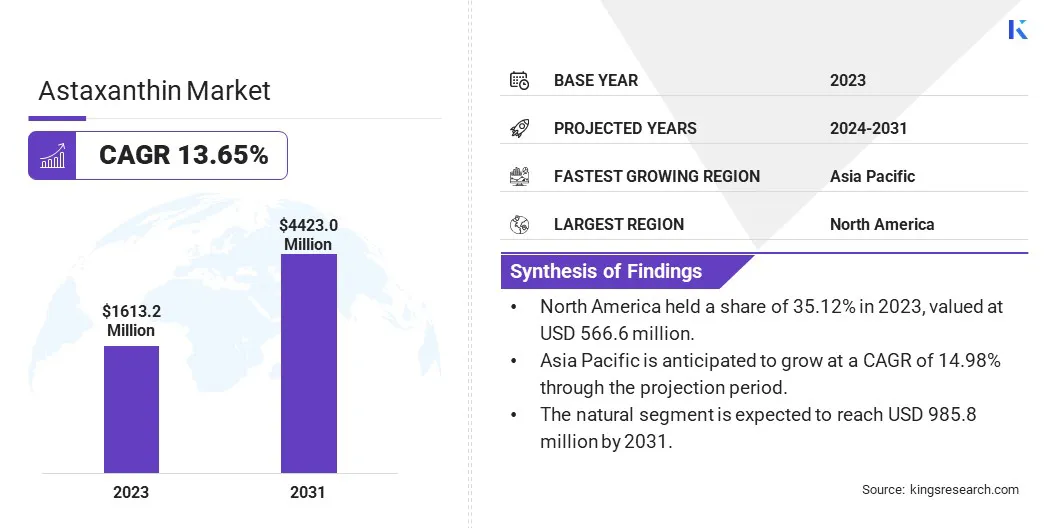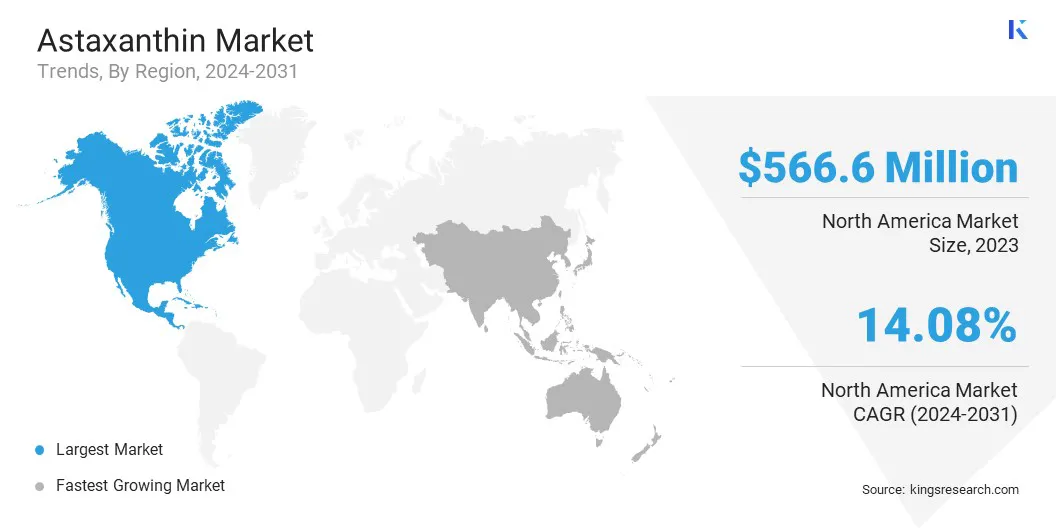Market Definition
Astaxanthin, a powerful antioxidant from the carotenoid family, is primarily found in microalgae, yeast, and certain marine organisms such as shrimp, krill, and salmon, giving them their pink or red hue.
Astaxanthin has been studied for its potential health benefits due to its strong antioxidant properties, which help neutralize free radicals in the body. It is often marketed as a dietary supplement and is believed to support skin health, reduce inflammation, improve eye health, and enhance athletic performance.
Astaxanthin Market Overview
Global astaxanthin market size was valued at USD 1613.2 million in 2023 and is projected to expand from USD 1805.8 million in 2024 to USD 4423.0 million by 2031, growing at a CAGR of 13.65% from 2024 to 2031.
The expansion of the market is driven by rising consumer demand for natural antioxidants, coupled with increased awareness of its health benefits across sectors such as nutraceuticals, cosmetics, and aquaculture. Additionally, advancements in production technologies and its expanding applications in sports nutrition, skin care, and anti-aging products support market growth.
Major companies operating in the astaxanthin industry are Cyanotech Corporation, Cardax, Inc., Beijing Gingko Group (BGG), Fuji Chemical Industries Co., Ltd, ENEOS Group, ALGAMO, BASF, Divi's Nutraceuticals, Valensa International, Otsuka Pharmaceutical Co., Ltd., Pond Tech, dsm-firmenich, Alfa Chemistry, Algatech Ltd., FENCHEM, and others.
Known for its antioxidant and anti-inflammatory properties, astaxanthin is widely used in dietary supplements and functional foods to support cardiovascular health, boost immunity, and combat oxidative stress. Additionally, the aging global population and the growing prevalence of chronic diseases are fueling the demand for these nutraceuticals.
- In May 2024, researchers at the Hefei Institutes of Physical Science, part of the Chinese Academy of Sciences, discovered a novel mechanism through which astaxanthin (AST) targets IL-6, helping to mitigate LPS-induced inflammatory responses in macrophages. This study highlights astaxanthin's potential anti-inflammatory properties.

Key Highlights:
- The global astaxanthin market size was recorded at USD 1613.2 million in 2023.
- The market is projected to grow at a CAGR of 13.65% from 2024 to 2031.
- North America held a share of 35.12% in 2023, valued at USD 566.6 million.
- The biomass/powder segment garnered USD 485.9 million in revenue in 2023.
- The natural segment is expected to reach USD 985.8 million by 2031.
- The animal feed and aquaculture segment is poised grow at a robust CAGR of 16.72% over the forecast period.
- Asia Pacific is anticipated to grow at a CAGR of 14.98% through the projection period.
Market Driver
"Growing Aquaculture Industry in Emerging Markets"
The rapid expansion of the aquaculture industry in emerging markets is bolstering the growth of the astaxanthin market. Astaxanthin is widely used as a feed additive in aquaculture to enhance the pigmentation, fertility, and immune health of fish and shellfish.
Emerging economies in Asia-Pacific and South America are investing heavily in aquaculture to meet the rising global demand for seafood, highlighting the need for high-quality feed ingredients such as astaxanthin. The increasing focus on sustainable aquaculture practices and the growing export of seafood from these regions are further fueling market growth.
- The 2024 edition of The State of World Fisheries and Aquaculture (SOFIA) reported that global fisheries and aquaculture production reached 223.2 million tonnes in 2022, marking a 4.4% increase from 2020. This total included 185.4 million tonnes of aquatic animals and 37.8 million tonnes of algae.
Market Challenge
"High Production Costs of Natural Astaxanthin"
The high production costs associated with natural astaxanthin, particularly from microalgae, present a significant challenge to the growth of the astaxanthin market. The cultivation, extraction, and purification processes require advanced technologies and substantial energy, leading to increased manufacturing expenses.
To address this issue, companies are investing in research and development to enhance cultivation efficiency and adopt cost-effective technologies such as closed-loop photo bioreactors and supercritical CO2 extraction.
Additionally, several firms are exploring alternative sources such as genetically modified yeast and sustainable biotechnological methods to lower production costs while maintaining product quality, thereby ensuring competitiveness in the global market.
Market Trend
"Advancements in Astaxanthin Production Technologies"
Technological advancements in astaxanthin production are emerging as a notable trend in the astaxanthin market. Innovations such as advanced microalgae cultivation methods, bioreactor systems, and closed-loop photobioreactors have improved production efficiency and reduced costs.
These advancements enable manufacturers to scale up production sustainably while maintaining high purity and quality. The adoption of cutting-edge extraction technologies, such as supercritical CO2 extraction, further enhances product yield and quality.
These innovations are helping companies meet the rising demand from various industries, including nutraceuticals, cosmetics, and aquaculture, while addressing supply constraints and cost challenges.
- In December 2023, a research team at the Hefei Institutes of Physical Science, Chinese Academy of Sciences (CAS), demonstrated that arginine supplementation significantly enhances the growth and astaxanthin production of Haematococcus pluvialis (H. pluvialis). The study revealed that arginine, an amino acid, promotes the overall growth of the microalgae and boosts its ability to produce astaxanthin, a key antioxidant with health benefits.
Astaxanthin Market Report Snapshot
| Segmentation |
Details |
| By Product |
Biomass/Powder, Oil, Softgels, Liquid, Others |
| By Source |
Natural, Synthetic |
| By Application |
Nutraceuticals, Cosmetics, Animal Feed and Aquaculture, Food, Others |
| By Region |
North America: U.S., Canada, Mexico |
| Europe: France, U.K., Spain, Germany, Italy, Russia, Rest of Europe |
| Asia-Pacific: China, Japan, India, Australia, ASEAN, South Korea, Rest of Asia-Pacific |
| Middle East & Africa: Turkey, UAE, Saudi Arabia, South Africa, Rest of Middle East & Africa |
| South America: Brazil, Argentina, Rest of South America |
Market Segmentation:
- By Product (Biomass/Powder, Oil, Softgels, Liquid, and Others): The biomass/powder segment earned USD 485.9 million in 2023 due to its high concentration, longer shelf life, cost-effectiveness, and versatility, making it widely preferred across nutraceuticals, animal feed, and cosmetics industries.
- By Source (Natural and Synthetic): The natural segment held a share of 61.11% in 2023, fueled by increasing consumer preference for sustainably sourced, eco-friendly products, supported by its superior bioavailability and regulatory approvals compared to synthetic alternatives.
- By Application (Nutraceuticals, Cosmetics, Animal Feed and Aquaculture, Food, and Others): The nutraceuticals segment is projected to reach USD 1931.0 million by 2031, largely attributed to its extensive use in dietary supplements and functional foods, characterized by rising consumer demand for natural antioxidants that support immunity, cardiovascular health, and overall wellness.
Astaxanthin Market Regional Analysis
Based on region, the global market has been classified into North America, Europe, Asia Pacific, Middle East & Africa, and Latin America.

North America astaxanthin market accounted for a notable share of around 35.12% in 2023, valued at USD 566.6 million. The growing fitness culture in the region is fueling the adoption of astaxanthin in sports nutrition, contributing to the expansion of the regional market.
Known for its benefits in enhancing endurance, reducing muscle fatigue, and accelerating recovery, astaxanthin has become a preferred ingredient in dietary supplements for athletes and fitness enthusiasts. The growing adoption of active lifestyles and rising gym memberships are boosting demand for astaxanthin-based sports supplements.
- The Health & Fitness Association (HFA) reported that in 2023, the U.S. fitness industry reached a record high, with 72.9 million Americans, representing 23.7% of the population aged six and older, holding memberships at fitness facilities. This underscores the vital role of fitness centers in promoting active lifestyles. Memberships saw a 5.8% year-over-year increase, the fastest growth rate recorded since 2017.
The growing preference for natural and clean-label products among consumers is positively impacting the regional market. Astaxanthin derived from natural sources, such as microalgae, is highly sought after for its safety and health benefits compared to synthetic alternatives.
Asia Pacific astaxanthin market is set to grow at a robust CAGR of 14.98% over the forecast period. The expanding cosmetics and personal care industry in Asia-Pacific is creating significant opportunities for domestic market expansion.
Consumers in South Korea and Japan are increasingly seeking natural and sustainable skincare solutions, boosting demand for products enriched with astaxanthin. The growing popularity of clean beauty trends and natural cosmetics in the region is further prompting manufacturers to develop innovative astaxanthin-based products.
- A March 2023 report by Euromonitor International projects the global beauty and personal care market to reach USD 547 billion by 2027, with Asia-Pacific accounting for 67% of the total growth value.
Regulatory Framework Also Plays a Significant Role in Shaping the Market
- In the U.S., the Food and Drug Administration (FDA) oversees the safety of dietary supplements containing astaxanthin. Manufacturers must adhere to the Dietary Supplement Health and Education Act (DSHEA) to ensure product safety and accurate labeling. Astaxanthin is generally recognized as safe (GRAS) when used appropriately.
- The European Commission, under Regulation (EU) 2023/1581, issued on August 1, 2023, expanded the use of astaxanthin-rich oleoresin from Haematococcus pluvialis alga in dietary supplements. The regulation sets maximum permissible levels of astaxanthin for different age groups and mandates specific labeling requirements, including declarations regarding its consumption. It prohibits use in children under 3 and 10 years old and warns against simultaneous consumption of supplements containing astaxanthin esters.
- The European Food Safety Authority (EFSA) evaluates health claims for astaxanthin, requiring scientific validation for approval. While permitted as a food additive and supplement, health claims must meet EFSA standards. Post-Brexit, the UK follows similar regulations, with the Food Standards Agency (FSA) overseeing the safety of food supplements containing astaxanthin and authorizing health claims.
- In China, the National Health Commission (NHC) regulates health foods, including supplements containing astaxanthin. It mandates product registration and scientific validation of health claims.
- In Japan, the Pharmaceuticals and Medical Devices Agency (PMDA) oversees the safety of health-related foods containing astaxanthin. Products can be marketed as Foods for Specified Health Uses (FOSHU) if they meet specific criteria.
Competitive Landscape
The astaxanthin market is characterized by a number of participants, including both established corporations and rising organizations. Market players are focusing on innovation and the expansion of production facilities to meet growing demand.
By investing in the development of natural astaxanthin derived from microalgae, they aim to enhance production capacity while ensuring sustainability.
This expansion strategy is essential to support the increasing use of astaxanthin in industries such as nutraceuticals, cosmetics, and aquaculture, thus contributing significantly to market growth. Companies are also adopting innovative extraction techniques to improve efficiency and reduce production costs.
- In May 2024, BGG and its subsidiary, Algae Health Sciences (AHS), completed a major expansion of their state-of-the-art, 100% glass tube photobioreactor microalgae farm. This expansion doubled the production capacity of BGG’s AstaZine® Natural Astaxanthin line, addressing the growing demand for high-quality natural astaxanthin.
List of Key Companies in Astaxanthin Market:
- Cyanotech Corporation
- Cardax, Inc.
- Beijing Gingko Group (BGG)
- Fuji Chemical Industries Co., Ltd
- ENEOS Group
- ALGAMO
- BASF
- Divi's Nutraceuticals
- Valensa International
- Otsuka Pharmaceutical Co., Ltd.
- Pond Tech
- dsm-firmenich
- Alfa Chemistry
- Algatech Ltd.
- FENCHEM
Recent Developments:
- In April 2023, Algalíf and Divis Nutraceuticals formed a partnership to launch AstaBead™, a groundbreaking product that features 5% natural astaxanthin in a microencapsulated oleoresin form. This innovative beadlet offers a new delivery system for natural astaxanthin, enhancing its stability and bioavailability in nutraceutical applications.
- In April 2024, Alfa Chemistry introduced a new line of premium natural astaxanthin ingredients to enhance health and well-being. Designed for researchers and manufacturers, this product range caters to dietary supplements, nutrition products, health formulations, and beverages, providing a versatile solution to meet growing demand in the wellness sector.
- In April 2023, AstaReal collaborated with i-ingredients, a prominent distributor of specialty ingredients, to expnad access to natural astaxanthin. This collaboration aligns with AstaReal's goals, as i-ingredients provides high-quality ingredients to industries such as food supplements, sports nutrition, pharmaceuticals, and animal feed, further expanding the reach of natural astaxanthin.


